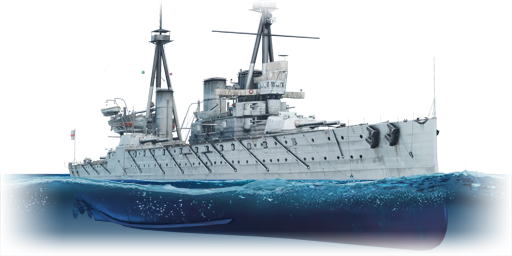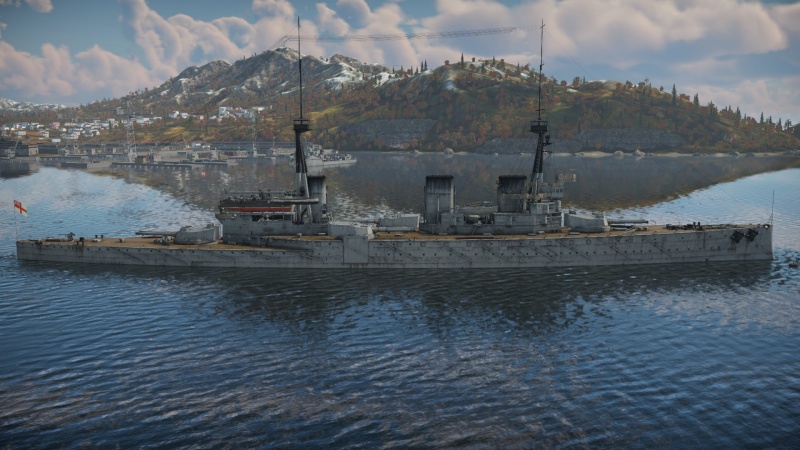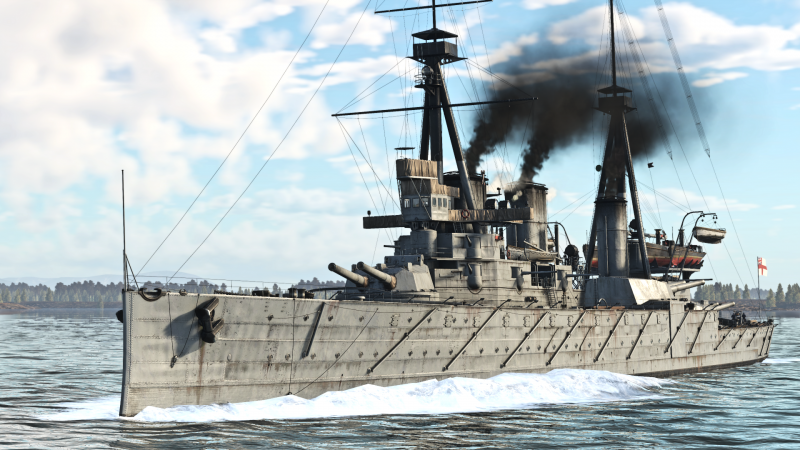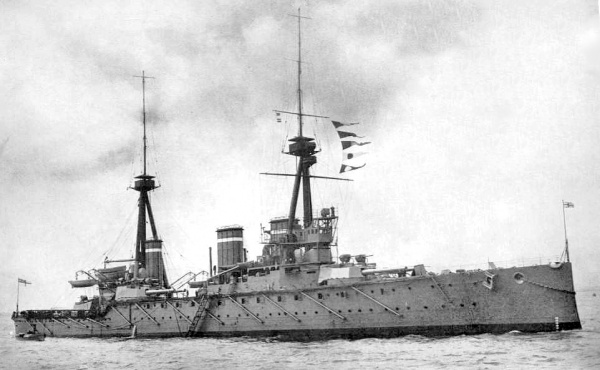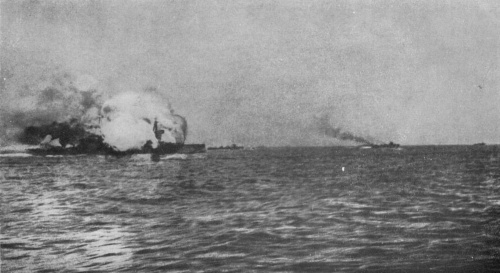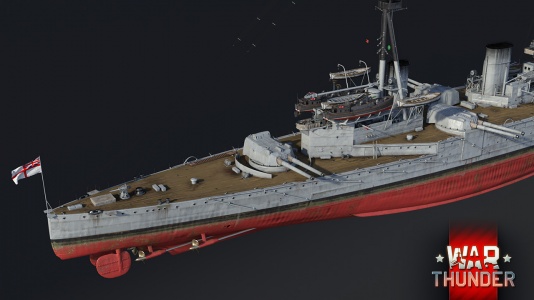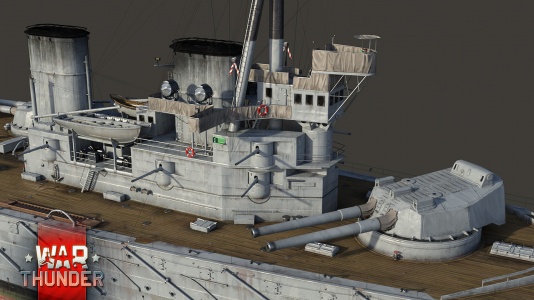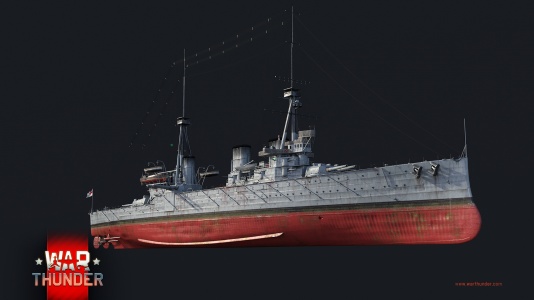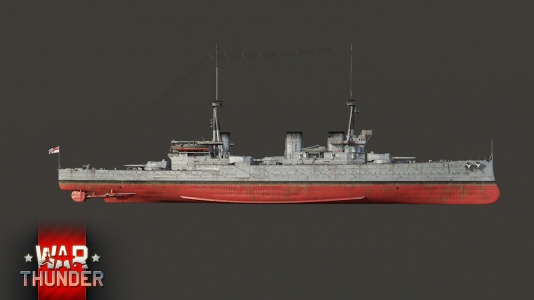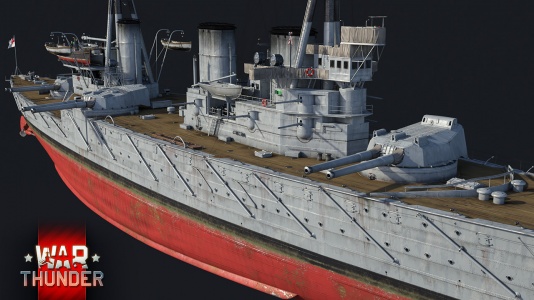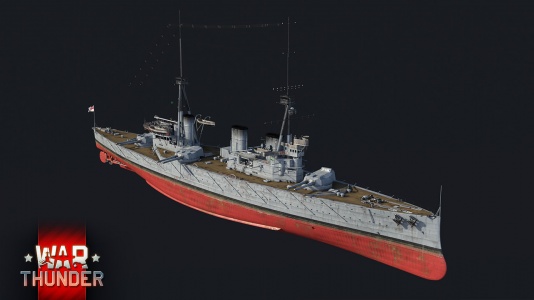Difference between revisions of "HMS Invincible"
(Added pros and cons.) (Tag: Visual edit) |
Ogaly_Bogaly (talk | contribs) (Primary armament, secondary armament, AA armament, and additional armament added description) (Tag: Visual edit) |
||
| (25 intermediate revisions by 9 users not shown) | |||
| Line 1: | Line 1: | ||
{{Specs-Card | {{Specs-Card | ||
|code=uk_battlecruiser_invincible | |code=uk_battlecruiser_invincible | ||
| − | |images={{Specs-Card-Image|GarageImage_{{PAGENAME}}.jpg}} | + | |images={{Specs-Card-Image|GarageImage_{{PAGENAME}}.jpg|ArtImage_{{PAGENAME}}.png}} |
}} | }} | ||
== Description == | == Description == | ||
<!-- ''In the first part of the description, cover the history of the ship's creation and military application. In the second part, tell the reader about using this ship in the game. Add a screenshot: if a beginner player has a hard time remembering vehicles by name, a picture will help them identify the ship in question.'' --> | <!-- ''In the first part of the description, cover the history of the ship's creation and military application. In the second part, tell the reader about using this ship in the game. Add a screenshot: if a beginner player has a hard time remembering vehicles by name, a picture will help them identify the ship in question.'' --> | ||
| − | + | The brainchild of First Sea Lord "Jacky" Fisher, the Invincible class were the first battlecruisers ever to be built, pioneering the design which was based around the idea of an enlarged and upgunned armoured cruiser that should have the firepower and protection to devastate enemy cruisers and raiders, yet be fast enough to outrun opposing battleships. Built between 1906 and 1909, the Invincible class formed the foundation of this new type of ship which became a key part of the ongoing Anglo-German naval arms race. | |
| − | + | ||
| − | + | HMS ''Invincible'' was laid down on 2 April 1906, launched on 13 April 1907, and commissioned on 20 March 1909. At the start of World War I, she took part in the Battle of the Heligoland Bight, then was transferred to the West Indies, where she participated in the Battle of the Falkland Islands, destroying a German squadron consisting of obsolete battleships and light cruiser alongside her sister ship ''Inflexible''. In February 1915, she returned to Britain, becoming the flagship of the Third Battlecruiser Squadron. During the Battle of Jutland on 31 May 1916, ''Invincible'' was sunk after a short duel with SMS ''Derfflinger''. | |
| + | |||
| + | Introduced in [[Update "Hot Tracks"]], HMS ''Invincible'' is presented in her 1916 refit. She is a typical representative of the large World War I-era warships in the game, with minimal AA defences and mediocre anti-torpedo protection, and generally weak armour for such a large vessel. However, as a representative of the battlecruiser class, she boasts decent mobility. | ||
== General info == | == General info == | ||
| Line 14: | Line 16: | ||
{{Specs-Fleet-Armour}} | {{Specs-Fleet-Armour}} | ||
<!-- ''Talk about the vehicle's armour. Note the most well-defended and most vulnerable zones, e.g. the ammo magazine. Evaluate the composition of components and assemblies responsible for movement and manoeuvrability. Evaluate the survivability of the primary and secondary armaments separately. Don't forget to mention the size of the crew, which plays an important role in fleet mechanics. Save tips on preserving survivability for the "Usage in battles" section. If necessary, use a graphical template to show the most well-protected or most vulnerable points in the armour.'' --> | <!-- ''Talk about the vehicle's armour. Note the most well-defended and most vulnerable zones, e.g. the ammo magazine. Evaluate the composition of components and assemblies responsible for movement and manoeuvrability. Evaluate the survivability of the primary and secondary armaments separately. Don't forget to mention the size of the crew, which plays an important role in fleet mechanics. Save tips on preserving survivability for the "Usage in battles" section. If necessary, use a graphical template to show the most well-protected or most vulnerable points in the armour.'' --> | ||
| − | + | HMS Invincible is a 20,000t vessel with 1,032 crew members, an average crew count for a battlecruiser. The ship has a 150 mm main armour belt which is backed up by 50 mm of turtleback armour and an array of coal bunkers. The main turrets have 177 mm armour on turret faces and barbettes. | |
| + | |||
| + | This leaves the ship reasonably resistant to 152 mm and 203 mm shells at long to medium ranges, nevertheless enemy battleships with their much larger cannons will have little trouble cleaving through your protection at any practical range. The armour is ineffective at stopping shells of a calibre larger than 283 mm. The lack of AA guns and rather thin deck armour is insufficient when it comes to fending off strike aircraft. | ||
| + | |||
| + | Whilst the belt armour does extend far enough below the waterline to give some level of protection from shallow torpedoes, the ship is still vulnerable to torpedoes which hit below the belt armour. | ||
=== Mobility === | === Mobility === | ||
| Line 33: | Line 39: | ||
{{main|305 mm/45 Mark X (305 mm)}} | {{main|305 mm/45 Mark X (305 mm)}} | ||
| − | + | HMS Invincible is armed with eight BL 12-inch Mk X cannons across four twin turrets. One is placed on the bow, one on the stern, and two amidships on the port and starboard wings. The allows for a full broadside of all eight guns, with the bow and stern turrets allowing for +/- 150 degrees of traverse, while the wing turrets only allow +180/-120 due to the placement of the funnels and the surrounding superstructure, which restrict cross-deck fire significantly. Fire control is on par with the preceding Courageous class [[HMS Glorious]] and other first-world war-era ships. The maximum fire rate is two rounds per minute per barrel with an ace crew. | |
| + | |||
| + | The BL 12-inch MK X cannon can fire three types of shell: HE Mk IIa, SAPCBC Mk VIIa, and APC Mk VIa. The HE Mk IIa shell holds an above-average 51.3 kg bursting charge for twelve-inch guns, resulting in the ability to wreak havoc on light vessels such as destroyers and some light cruisers. The SAPCBC Mk VIIa shell balances the penetration of the APC and the large amount of explosive of the HE shell, and thus it is best suited for dealing with medium-armoured opponents such as cruisers, with a bursting charge of 36.3 kg and 240mm of penetration at 2,500 m. However, it is lacking penetration for dealing with heavy battleship amour. The APC Mk VIa trades the high explosive bursting charge of the SAPCBC and HE for amour penetration and thus is the main shell for dealing with heavily armoured opponents such as battleships. It contains a bursting charge of 13.2 kg, which is sub-par for dealing with light to medium opponents.{{:305 mm/45 Mark X (305 mm)/Ammunition|305 mm Mark IIa HE, 305 mm Mark VIa APC, 305 mm Mark VIIa SAPCBC}} | ||
=== Secondary armament === | === Secondary armament === | ||
| Line 40: | Line 48: | ||
{{main|4 inch/40 QF mark III (102 mm)}} | {{main|4 inch/40 QF mark III (102 mm)}} | ||
| − | + | HMS Invincible has a secondary armament of twelve 4 Inch/40 QF Mk III cannons placed in eight casemate mounts on the forward superstructure, and four open mounts on the rear superstructure. These have a fire rate of 20 rounds per minute with an ace-crew. | |
| + | |||
| + | These guns can fire either HE or SAP, with both types of shells having a small bursting charge owing to their small calibre, resulting in the ability to damage destroyers, but not inflict serous damage on cruisers and battleships. | ||
| + | |||
| + | {{:4 inch/40 QF mark III (102 mm)/Ammunition|4 inch HE, 4 inch SAP}} | ||
=== Anti-aircraft armament === | === Anti-aircraft armament === | ||
| Line 47: | Line 59: | ||
{{main|76 mm/45 QF 3in 20cwt HA Mark I (76 mm)|3 pdr QF Hotchkiss (47 mm)}} | {{main|76 mm/45 QF 3in 20cwt HA Mark I (76 mm)|3 pdr QF Hotchkiss (47 mm)}} | ||
| − | + | HMS invincible only has a single 3 inch 20cwt gun mounted for anti-aircraft purpose. It is placed at the stern of the ship, and can only fire HE, severely limiting its usefulness as an anti-air weapon, as it lacks both ammunition, weight of fire, and good firing arcs. | |
| − | === | + | === Additional armament === |
| − | <!-- '' | + | {{Specs-Fleet-Additional}} |
| + | <!-- ''Describe the available additional armaments of the ship: depth charges, mines, torpedoes. Talk about their positions, available ammunition and launch features such as dead zones of torpedoes. If there is no additional armament, remove this section.'' --> | ||
{{main|R.G.F. Mark VI** (450 mm)}} | {{main|R.G.F. Mark VI** (450 mm)}} | ||
| − | + | HMS invincible is armed with 5 underwater fixed 18 inch torpedo tubes, with one placed forward along the broadside, one placed aft on the broadside, and one on the stern looking backwards. This results in a total torpedo broadside of 2 torpedoes before a reload is needed. | |
| − | |||
| − | |||
| − | |||
| − | |||
| − | + | These fire the R.G.F Mk VI** torpedo traveling 5.49 km at 56 km/h with a 134kg warhead. | |
== Usage in battles == | == Usage in battles == | ||
<!-- ''Describe the technique of using this ship, the characteristics of her use in a team and tips on strategy. Abstain from writing an entire guide – don't try to provide a single point of view, but give the reader food for thought. Talk about the most dangerous opponents for this vehicle and provide recommendations on fighting them. If necessary, note the specifics of playing with this vehicle in various modes (AB, RB, SB).'' --> | <!-- ''Describe the technique of using this ship, the characteristics of her use in a team and tips on strategy. Abstain from writing an entire guide – don't try to provide a single point of view, but give the reader food for thought. Talk about the most dangerous opponents for this vehicle and provide recommendations on fighting them. If necessary, note the specifics of playing with this vehicle in various modes (AB, RB, SB).'' --> | ||
''Describe the technique of using this ship, the characteristics of her use in a team and tips on strategy. Abstain from writing an entire guide – don't try to provide a single point of view, but give the reader food for thought. Talk about the most dangerous opponents for this vehicle and provide recommendations on fighting them. If necessary, note the specifics of playing with this vehicle in various modes (AB, RB, SB).'' | ''Describe the technique of using this ship, the characteristics of her use in a team and tips on strategy. Abstain from writing an entire guide – don't try to provide a single point of view, but give the reader food for thought. Talk about the most dangerous opponents for this vehicle and provide recommendations on fighting them. If necessary, note the specifics of playing with this vehicle in various modes (AB, RB, SB).'' | ||
| − | |||
| − | |||
| − | |||
| − | |||
| − | |||
| − | |||
| − | |||
| − | |||
| − | |||
| − | |||
| − | |||
| − | |||
| − | |||
| − | |||
| − | |||
| − | |||
| − | |||
| − | |||
| − | |||
| − | |||
| − | |||
| − | |||
| − | |||
| − | |||
| − | |||
| − | |||
| − | |||
| − | |||
| − | |||
| − | |||
| − | |||
| − | |||
| − | |||
| − | |||
| − | |||
| − | |||
| − | |||
| − | |||
| − | |||
| − | |||
| − | |||
=== Pros and cons === | === Pros and cons === | ||
<!-- ''Summarise and briefly evaluate the vehicle in terms of its characteristics and combat effectiveness. Mark its pros and cons in the bulleted list. Try not to use more than 6 points for each of the characteristics. Avoid using categorical definitions such as "bad", "good" and the like - use substitutions with softer forms such as "inadequate" and "effective".'' --> | <!-- ''Summarise and briefly evaluate the vehicle in terms of its characteristics and combat effectiveness. Mark its pros and cons in the bulleted list. Try not to use more than 6 points for each of the characteristics. Avoid using categorical definitions such as "bad", "good" and the like - use substitutions with softer forms such as "inadequate" and "effective".'' --> | ||
| − | |||
'''Pros:''' | '''Pros:''' | ||
| − | * Main battery of eight | + | * Main battery of eight 305 mm guns with access to SAP rounds can make short work of enemy cruisers, and APC can punish larger targets |
| − | * Faster than the other | + | * Faster than the other capital ships, inferior only to [[SMS Von der Tann]] in terms of top speed |
| − | * Belt armour can shrug off medium calibre gunfire from cruisers and destroyers, and extends below the waterline to give protection against shallow torpedoes | + | * Belt armour can shrug off medium calibre gunfire from cruisers and destroyers, and extends below the waterline to give protection against shallow torpedoes |
| − | * Shell rooms are well below the waterline and hard to hit with gunfire | + | * Shell rooms are well below the waterline and hard to hit with gunfire |
| − | * Numerous secondary battery guns with a high rate of fire that can easily deal with close range attacks from smaller unarmoured vessels | + | * Numerous secondary battery guns with a high rate of fire that can easily deal with close range attacks from smaller unarmoured vessels |
| − | * Has underwater | + | * Has underwater torpedo launchers, which can potentially catch close targets unaware |
| − | |||
| − | |||
'''Cons:''' | '''Cons:''' | ||
| − | * Vertical armour is very weak against large calibre guns from other capital ships; battleships can often cause crippling damage | + | * Vertical armour is very weak against large calibre guns from other capital ships; battleships can often cause crippling damage |
| − | * Non-existent deck armour and extremely poor anti-aircraft armament makes | + | * Non-existent deck armour and extremely poor anti-aircraft armament makes the Invincible highly vulnerable to bombers |
| − | * | + | * 305 mm guns struggle to penetrate battleship belt armour beyond 10km, and the APC rounds suffer from poor post-penetration damage |
| − | * Secondary battery SAP shells have low penetration; the guns will struggle to damage even most light cruisers | + | * Can only fire a full broadside while parallel to an opponent - Angling the ship will only allow a broadside of 6 guns |
| − | * Main battery turret armour is thin on the roof, often resulting in disabled turrets or damage gun breeches | + | * Secondary battery SAP shells have low penetration; the guns will struggle to damage even most light cruisers |
| − | * Vulnerable to deep running torpedoes | + | * Main battery turret armour is thin on the roof, often resulting in disabled turrets or damage gun breeches |
| − | * Underwater torpedoes have low range and a relatively small warhead in comparison to most deck mounted torpedoes aboard cruisers and destroyers | + | * Vulnerable to deep running torpedoes |
| − | + | * Underwater torpedoes have low range and a relatively small warhead in comparison to most deck mounted torpedoes aboard cruisers and destroyers | |
| − | |||
== History == | == History == | ||
<!-- ''Describe the history of the creation and combat usage of the ship in more detail than in the introduction. If the historical reference turns out to be too long, take it to a separate article, taking a link to the article about the ship and adding a block "/History" (example: <nowiki>https://wiki.warthunder.com/(Ship-name)/History</nowiki>) and add a link to it here using the <code>main</code> template. Be sure to reference text and sources by using <code><nowiki><ref></ref></nowiki></code>, as well as adding them at the end of the article with <code><nowiki><references /></nowiki></code>. This section may also include the ship's dev blog entry (if applicable) and the in-game encyclopedia description (under <code><nowiki>=== In-game description ===</nowiki></code>, also if applicable).'' --> | <!-- ''Describe the history of the creation and combat usage of the ship in more detail than in the introduction. If the historical reference turns out to be too long, take it to a separate article, taking a link to the article about the ship and adding a block "/History" (example: <nowiki>https://wiki.warthunder.com/(Ship-name)/History</nowiki>) and add a link to it here using the <code>main</code> template. Be sure to reference text and sources by using <code><nowiki><ref></ref></nowiki></code>, as well as adding them at the end of the article with <code><nowiki><references /></nowiki></code>. This section may also include the ship's dev blog entry (if applicable) and the in-game encyclopedia description (under <code><nowiki>=== In-game description ===</nowiki></code>, also if applicable).'' --> | ||
| + | [[File:HMS Invincible (1907) British Battleship.jpg|thumb|600x600px|A photograph of HMS Invincible, the first British Battlecruiser, in 1907.]] | ||
| + | HMS Invincible was the lead ship of her class of three battlecruisers built for the Royal Navy. She was the first modern battlecruiser ever built, and pioneered the ship type, featuring less armour in exchange for more speed. Her construction led to a "battlecruiser arms race", including ships such as the German [[SMS Von der Tann|Von Der Tann]] and Derflingger classes as well as the Japanese Kongo class. During the First World War, Invincible participated in the Battle of the Heligoland Bight, as well as the Falklands Battle where she and her sister ship Inflexible sank the armoured cruisers Scharnhorst and Gneisenau. She ultimately met her demise at the Battle of Jutland, when her magazines detonated following hits from the German force. | ||
| + | |||
| + | === Design and development === | ||
| + | Invincible, as the first battlecruiser ever built, was the brainchild of First Sea Lord Jackie Fisher, who was responsible for a wide range of innovations including the Dreadnought. The ships were designed to be fast, with a top speed of 25 knots (46 km/h), but also extremely well armed, with a main battery of 12 inch (305 mm) guns. However, this came at the expense of armour, meaning that Invincible had a weaker armour protection compared to the dreadnoughts. The massive 41 000 horsepower engines that powered the Invincible took up a massive amount of space inside the hull, requiring a reduction in armour. | ||
| + | |||
| + | Invincible, being a larger vessel than her armoured-cruiser predecessors, displaced over 20 000 tons at full load. She had an armament of eight 12 inch (305 mm) guns in four twin turrets, with one fore, one aft, and two on beam positions. The turrets were placed in a position so that all four turrets could fire on a broadside. Invincible carried a secondary armament of twelve 4 inch 40 QF naval guns in single mounts, placed across the fore and rear superstructures. She carried a single 76 mm and 47 mm gun for anti-aircraft defence, as well as four 450 mm torpedoes. Invincible was laid down in April of 1906, and launched a year later in 1907. She was fully commissioned in 1909 and entered service with the 1st Cruiser Squadron of the British Grand Fleet. | ||
| + | |||
| + | === Operational History === | ||
| + | Invincible entered service with the British Grand Fleet and participated in fleet manoeuvres along with the rest of the fleet. However, it was apparent during her early service that her main turrets were problematic as the faulty electric turret horizontal drives prevented them from turning properly. As a result, the battlecruiser spent much of late 1913 and early 1914 in dock, receiving new, hydraulic turret drives to replace her electric ones. She was also fitted with a new ranging fire director, but this had not been completed by the time of the outbreak of the First World War. | ||
| + | |||
| + | ==== Heligoland Bight and the Falklands ==== | ||
| + | Following the start of the First World War, Invincible saw her first action at the Battle of Heligoland Bight. There, she fired 18 rounds at the crippled cruiser Cöln, but failed to obtain hits. Later, Invincible participated in a more important action, the Battle of the Falklands. As part of the British West Indies squadron commanded by Rear Admiral Christopher Cradock, she steamed from Port Stanley (in the Falklands) with her sister ship Inflexible to intercept the German squadron led by Admiral Von Spee; Spee's cruiser squadron, led by armoured cruisers Scharnhorst and Gneisenau, attempted to attack the British base at Port Stanley hours before. As the battlecruisers had a 5-knot advantage over the German armoured cruisers, they quickly caught up and began straddling the German cruisers with 12 inch shells. After a several hour long battle, both Scharnhorst and Gneisenau were sunk, the former with no survivors. Invincible was hit numerous times, but suffered no significant damage. | ||
| + | |||
| + | After the Falklands battle, Invincible returned to Port Stanley for repairs, followed by a more lengthy refit at Gibraltar. During this time, her ranging director was completed (it had been left unfinished with the outbreak of war) and her funnel was extended to reduce the amount of smoke entering the bridge and forward superstructure. | ||
| + | |||
| + | ==== Battle of Jutland and sinking ==== | ||
| + | [[File:InvincibleBlowingUpJutland1916.jpg|thumb|500x500px|HMS Invincible blowing up after a German shell detonated her ammunition magazines.]] | ||
| + | Invincible ultimately met her demise at the Battle of Jutland in 1916, just a year after she sank the cruisers Scharnhorst and Gneisenau at the Falklands. In May of that year, she was assigned to Admiral Beatty's battlecruiser group and ordered to cruise into the north seas to intercept a potential breakout of the German fleet. Soon after, Invincible, along with her sister ships Inflexible and Indomitable, spotted a group of seven enemy ships including two armoured cruisers and promptly fired upon them. They succeeded in crippling the cruiser Wiesbaden with a hit to the engine room, as well as a similar heavy hit to the cruiser Pillau. | ||
| + | |||
| + | Soon after, Beatty's battlecruisers spotted the German battlecruiser line, and promptly opened fire on the battlecruisers Lutzow and Derfflinger. Invincible hit Lutzow twice beneath the waterline, which would eventually lead to her demise. However, she ended up directly in front of Lutzow and Derfllinger, who fired several salvoes at her. One of these shots hit the ship's midships 12 inch shell magazines, which exploded and blew the ship in half. Almost her entire crew of 1026 were killed, including her commanding officer Rear Admiral Horace Hood; six survivors were rescued by escorting destroyers. Hood's widow would later launch the battlecruiser/fast battleship HMS Hood, the heaviest battleship in the world for 20 years. | ||
| + | |||
| + | Invincible lies at a depth of 55 metres in the North Sea, cut in half by the massive magazine explosion that doomed her. Her wreck is protected by the Protection of Military Remains act of 1986. | ||
| + | |||
=== [[wt:en/news/6974-development-heroes-of-jutland-hms-invincible-en|Devblog]] === | === [[wt:en/news/6974-development-heroes-of-jutland-hms-invincible-en|Devblog]] === | ||
| − | HMS Invincible was laid down in April 1906 as the lead ship of her class of three new armoured cruisers, intended to replace the preceding Minotaur-class. The ship was launched a year later and completed in March 1909, subsequently being commissioned into service with the Royal Navy. Thereafter, HMS Invincible took part in fleet | + | HMS Invincible was laid down in April 1906 as the lead ship of her class of three new armoured cruisers, intended to replace the preceding Minotaur-class. The ship was launched a year later and completed in March 1909, subsequently being commissioned into service with the Royal Navy. Thereafter, HMS Invincible took part in fleet manoeuvres and several reviews before being sent to drydock for refit. In 1911, the warship was officially redesignated into a battlecruiser, thus becoming the first ship of this kind. |
| − | In 1913, HMS Invincible was ordered to the dockyard once more to replace her electrically powered turret traverse mechanisms with hydraulic ones in order to fix ongoing problems and make the ship battle-worthy. However, while works were still being undertaken, the declaration of war on Germany in August 1914 | + | In 1913, HMS Invincible was ordered to the dockyard once more to replace her electrically powered turret traverse mechanisms with hydraulic ones in order to fix ongoing problems and make the ship battle-worthy. However, while works were still being undertaken, the declaration of war on Germany in August 1914 signalled the start of WWI and HMS Invincible was quickly recommissioned. |
Already at the outbreak of the conflict, HMS Invincible saw herself in the thick of the action, engaging German ships at the Battle of Heligoland Bight in late August 1914. Later that year, in December, HMS Invincible, along with her sister ship HMS Inflexible, took part in the Battle of the Falkland Islands, sinking the two German armoured cruisers, Gneisenau and Scharnhorst, during the engagement. | Already at the outbreak of the conflict, HMS Invincible saw herself in the thick of the action, engaging German ships at the Battle of Heligoland Bight in late August 1914. Later that year, in December, HMS Invincible, along with her sister ship HMS Inflexible, took part in the Battle of the Falkland Islands, sinking the two German armoured cruisers, Gneisenau and Scharnhorst, during the engagement. | ||
| Line 145: | Line 133: | ||
== Media == | == Media == | ||
| − | <!-- ''Excellent additions to the article would be video guides, screenshots from the game, and photos.'' --><gallery mode="packed" caption="HMS Invincible Devblog Images" heights=" | + | <!-- ''Excellent additions to the article would be video guides, screenshots from the game, and photos.'' --> |
| + | |||
| + | ;Skins | ||
| + | |||
| + | * [https://live.warthunder.com/feed/camouflages/?vehicle=uk_battlecruiser_invincible Skins and camouflages for the {{PAGENAME}} from live.warthunder.com.] | ||
| + | |||
| + | ;Images | ||
| + | <gallery mode="packed" caption="HMS Invincible Devblog Images" heights="200"> | ||
File:HMS Invincible WTWallpaper 001.jpg| | File:HMS Invincible WTWallpaper 001.jpg| | ||
File:HMS Invincible WTWallpaper 002.jpg| | File:HMS Invincible WTWallpaper 002.jpg| | ||
| Line 153: | Line 148: | ||
File:HMS Invincible WTWallpaper 006.jpg| | File:HMS Invincible WTWallpaper 006.jpg| | ||
</gallery> | </gallery> | ||
| + | |||
| + | ;Videos | ||
| + | {{Youtube-gallery|-LCzBAASxbo|'''HMS Invincible vs Von der Tann - Vehicle Comparison''' - ''Flipped StuG''}} | ||
== See also == | == See also == | ||
| Line 158: | Line 156: | ||
* ''reference to the series of the ship;'' | * ''reference to the series of the ship;'' | ||
* ''links to approximate analogues of other nations and research trees.'' --> | * ''links to approximate analogues of other nations and research trees.'' --> | ||
| − | |||
| − | * | + | ;Other WW1-era battlecruisers |
| − | * | + | |
| + | * [[SMS Von der Tann]] | ||
| + | * [[IJN Ikoma]] | ||
== External links == | == External links == | ||
| Line 170: | Line 169: | ||
* [[wt:en/news/6974-development-heroes-of-jutland-hms-invincible-en|[Devblog] Heroes of Jutland: HMS Invincible]] | * [[wt:en/news/6974-development-heroes-of-jutland-hms-invincible-en|[Devblog] Heroes of Jutland: HMS Invincible]] | ||
| + | === References === | ||
| + | |||
| + | * Bowman, C. (2016, July 23). Dive on the wreck of HMS Invincible (Watch). Retrieved January 04, 2021, from <nowiki>https://www.warhistoryonline.com/featured/dive-wreck-hms-invincible.html</nowiki> | ||
| + | * Naval Encyclopedia. (2020, October 15). Invincible class battlecruisers (1907). Retrieved January 04, 2021, from <nowiki>https://www.naval-encyclopedia.com/ww1/UK/invincible-class-battlecruisers/</nowiki> | ||
| + | |||
| + | {{Manufacturer Vickers-Armstrongs}} | ||
{{Britain battlecruisers}} | {{Britain battlecruisers}} | ||
Latest revision as of 23:40, 19 October 2024
Contents
Description
The brainchild of First Sea Lord "Jacky" Fisher, the Invincible class were the first battlecruisers ever to be built, pioneering the design which was based around the idea of an enlarged and upgunned armoured cruiser that should have the firepower and protection to devastate enemy cruisers and raiders, yet be fast enough to outrun opposing battleships. Built between 1906 and 1909, the Invincible class formed the foundation of this new type of ship which became a key part of the ongoing Anglo-German naval arms race.
HMS Invincible was laid down on 2 April 1906, launched on 13 April 1907, and commissioned on 20 March 1909. At the start of World War I, she took part in the Battle of the Heligoland Bight, then was transferred to the West Indies, where she participated in the Battle of the Falkland Islands, destroying a German squadron consisting of obsolete battleships and light cruiser alongside her sister ship Inflexible. In February 1915, she returned to Britain, becoming the flagship of the Third Battlecruiser Squadron. During the Battle of Jutland on 31 May 1916, Invincible was sunk after a short duel with SMS Derfflinger.
Introduced in Update "Hot Tracks", HMS Invincible is presented in her 1916 refit. She is a typical representative of the large World War I-era warships in the game, with minimal AA defences and mediocre anti-torpedo protection, and generally weak armour for such a large vessel. However, as a representative of the battlecruiser class, she boasts decent mobility.
General info
Survivability and armour
HMS Invincible is a 20,000t vessel with 1,032 crew members, an average crew count for a battlecruiser. The ship has a 150 mm main armour belt which is backed up by 50 mm of turtleback armour and an array of coal bunkers. The main turrets have 177 mm armour on turret faces and barbettes.
This leaves the ship reasonably resistant to 152 mm and 203 mm shells at long to medium ranges, nevertheless enemy battleships with their much larger cannons will have little trouble cleaving through your protection at any practical range. The armour is ineffective at stopping shells of a calibre larger than 283 mm. The lack of AA guns and rather thin deck armour is insufficient when it comes to fending off strike aircraft.
Whilst the belt armour does extend far enough below the waterline to give some level of protection from shallow torpedoes, the ship is still vulnerable to torpedoes which hit below the belt armour.
Mobility
Write about the ship's mobility. Evaluate its power and manoeuvrability, rudder rerouting speed, stopping speed at full tilt, with its maximum forward and reverse speed.
| Mobility Characteristics | |||
|---|---|---|---|
| Game Mode | Upgrade Status | Maximum Speed (km/h) | |
| Forward | Reverse | ||
| AB | |||
| Upgraded | 58 | 28 | |
| RB/SB | |||
| Upgraded | 49 | 24 | |
Modifications and economy
Armament
Primary armament
HMS Invincible is armed with eight BL 12-inch Mk X cannons across four twin turrets. One is placed on the bow, one on the stern, and two amidships on the port and starboard wings. The allows for a full broadside of all eight guns, with the bow and stern turrets allowing for +/- 150 degrees of traverse, while the wing turrets only allow +180/-120 due to the placement of the funnels and the surrounding superstructure, which restrict cross-deck fire significantly. Fire control is on par with the preceding Courageous class HMS Glorious and other first-world war-era ships. The maximum fire rate is two rounds per minute per barrel with an ace crew.
The BL 12-inch MK X cannon can fire three types of shell: HE Mk IIa, SAPCBC Mk VIIa, and APC Mk VIa. The HE Mk IIa shell holds an above-average 51.3 kg bursting charge for twelve-inch guns, resulting in the ability to wreak havoc on light vessels such as destroyers and some light cruisers. The SAPCBC Mk VIIa shell balances the penetration of the APC and the large amount of explosive of the HE shell, and thus it is best suited for dealing with medium-armoured opponents such as cruisers, with a bursting charge of 36.3 kg and 240mm of penetration at 2,500 m. However, it is lacking penetration for dealing with heavy battleship amour. The APC Mk VIa trades the high explosive bursting charge of the SAPCBC and HE for amour penetration and thus is the main shell for dealing with heavily armoured opponents such as battleships. It contains a bursting charge of 13.2 kg, which is sub-par for dealing with light to medium opponents.
| Penetration statistics | |||||||
|---|---|---|---|---|---|---|---|
| Ammunition | Type of warhead |
Penetration @ 0° Angle of Attack (mm) | |||||
| 1,000 m | 2,500 m | 5,000 m | 7,500 m | 10,000 m | 15,000 m | ||
| Mark IIa HE | HE | 72 | 72 | 72 | 72 | 72 | 72 |
| Mark VIa APC | APC | 501 | 453 | 394 | 352 | 321 | 280 |
| Mark VIIa SAPCBC | SAPCBC | 266 | 240 | 209 | 186 | 170 | 148 |
| Shell details | ||||||||||||
|---|---|---|---|---|---|---|---|---|---|---|---|---|
| Ammunition | Type of warhead |
Velocity (m/s) |
Projectile mass (kg) |
Fuse delay (s) |
Fuse sensitivity (mm) |
Explosive mass (TNT equivalent) (kg) |
Ricochet | |||||
| 0% | 50% | 100% | ||||||||||
| Mark IIa HE | HE | 831 | 386 | 0 | 0.1 | 53.13 | 79° | 80° | 81° | |||
| Mark VIa APC | APC | 831 | 389.8 | 0.025 | 17 | 13.2 | 48° | 63° | 71° | |||
| Mark VIIa SAPCBC | SAPCBC | 831 | 386 | 0.035 | 17 | 36.3 | 48° | 63° | 71° | |||
Secondary armament
HMS Invincible has a secondary armament of twelve 4 Inch/40 QF Mk III cannons placed in eight casemate mounts on the forward superstructure, and four open mounts on the rear superstructure. These have a fire rate of 20 rounds per minute with an ace-crew.
These guns can fire either HE or SAP, with both types of shells having a small bursting charge owing to their small calibre, resulting in the ability to damage destroyers, but not inflict serous damage on cruisers and battleships.
| Penetration statistics | |||||||
|---|---|---|---|---|---|---|---|
| Ammunition | Type of warhead |
Penetration @ 0° Angle of Attack (mm) | |||||
| 1,000 m | 2,500 m | 5,000 m | 7,500 m | 10,000 m | 15,000 m | ||
| 4 inch HE | HE | 11 | 11 | 11 | 11 | 11 | 11 |
| 4 inch SAP | SAP | 74 | 59 | 42 | 31 | 25 | 23 |
| Shell details | ||||||||||||
|---|---|---|---|---|---|---|---|---|---|---|---|---|
| Ammunition | Type of warhead |
Velocity (m/s) |
Projectile mass (kg) |
Fuse delay (s) |
Fuse sensitivity (mm) |
Explosive mass (TNT equivalent) (g) |
Ricochet | |||||
| 0% | 50% | 100% | ||||||||||
| 4 inch HE | HE | 701 | 14.06 | 0 | 0.1 | 721 | 79° | 80° | 81° | |||
| 4 inch SAP | SAP | 701 | 15.2 | 0.015 | 5 | 520 | 47° | 60° | 65° | |||
Anti-aircraft armament
HMS invincible only has a single 3 inch 20cwt gun mounted for anti-aircraft purpose. It is placed at the stern of the ship, and can only fire HE, severely limiting its usefulness as an anti-air weapon, as it lacks both ammunition, weight of fire, and good firing arcs.
Additional armament
HMS invincible is armed with 5 underwater fixed 18 inch torpedo tubes, with one placed forward along the broadside, one placed aft on the broadside, and one on the stern looking backwards. This results in a total torpedo broadside of 2 torpedoes before a reload is needed.
These fire the R.G.F Mk VI** torpedo traveling 5.49 km at 56 km/h with a 134kg warhead.
Usage in battles
Describe the technique of using this ship, the characteristics of her use in a team and tips on strategy. Abstain from writing an entire guide – don't try to provide a single point of view, but give the reader food for thought. Talk about the most dangerous opponents for this vehicle and provide recommendations on fighting them. If necessary, note the specifics of playing with this vehicle in various modes (AB, RB, SB).
Pros and cons
Pros:
- Main battery of eight 305 mm guns with access to SAP rounds can make short work of enemy cruisers, and APC can punish larger targets
- Faster than the other capital ships, inferior only to SMS Von der Tann in terms of top speed
- Belt armour can shrug off medium calibre gunfire from cruisers and destroyers, and extends below the waterline to give protection against shallow torpedoes
- Shell rooms are well below the waterline and hard to hit with gunfire
- Numerous secondary battery guns with a high rate of fire that can easily deal with close range attacks from smaller unarmoured vessels
- Has underwater torpedo launchers, which can potentially catch close targets unaware
Cons:
- Vertical armour is very weak against large calibre guns from other capital ships; battleships can often cause crippling damage
- Non-existent deck armour and extremely poor anti-aircraft armament makes the Invincible highly vulnerable to bombers
- 305 mm guns struggle to penetrate battleship belt armour beyond 10km, and the APC rounds suffer from poor post-penetration damage
- Can only fire a full broadside while parallel to an opponent - Angling the ship will only allow a broadside of 6 guns
- Secondary battery SAP shells have low penetration; the guns will struggle to damage even most light cruisers
- Main battery turret armour is thin on the roof, often resulting in disabled turrets or damage gun breeches
- Vulnerable to deep running torpedoes
- Underwater torpedoes have low range and a relatively small warhead in comparison to most deck mounted torpedoes aboard cruisers and destroyers
History
HMS Invincible was the lead ship of her class of three battlecruisers built for the Royal Navy. She was the first modern battlecruiser ever built, and pioneered the ship type, featuring less armour in exchange for more speed. Her construction led to a "battlecruiser arms race", including ships such as the German Von Der Tann and Derflingger classes as well as the Japanese Kongo class. During the First World War, Invincible participated in the Battle of the Heligoland Bight, as well as the Falklands Battle where she and her sister ship Inflexible sank the armoured cruisers Scharnhorst and Gneisenau. She ultimately met her demise at the Battle of Jutland, when her magazines detonated following hits from the German force.
Design and development
Invincible, as the first battlecruiser ever built, was the brainchild of First Sea Lord Jackie Fisher, who was responsible for a wide range of innovations including the Dreadnought. The ships were designed to be fast, with a top speed of 25 knots (46 km/h), but also extremely well armed, with a main battery of 12 inch (305 mm) guns. However, this came at the expense of armour, meaning that Invincible had a weaker armour protection compared to the dreadnoughts. The massive 41 000 horsepower engines that powered the Invincible took up a massive amount of space inside the hull, requiring a reduction in armour.
Invincible, being a larger vessel than her armoured-cruiser predecessors, displaced over 20 000 tons at full load. She had an armament of eight 12 inch (305 mm) guns in four twin turrets, with one fore, one aft, and two on beam positions. The turrets were placed in a position so that all four turrets could fire on a broadside. Invincible carried a secondary armament of twelve 4 inch 40 QF naval guns in single mounts, placed across the fore and rear superstructures. She carried a single 76 mm and 47 mm gun for anti-aircraft defence, as well as four 450 mm torpedoes. Invincible was laid down in April of 1906, and launched a year later in 1907. She was fully commissioned in 1909 and entered service with the 1st Cruiser Squadron of the British Grand Fleet.
Operational History
Invincible entered service with the British Grand Fleet and participated in fleet manoeuvres along with the rest of the fleet. However, it was apparent during her early service that her main turrets were problematic as the faulty electric turret horizontal drives prevented them from turning properly. As a result, the battlecruiser spent much of late 1913 and early 1914 in dock, receiving new, hydraulic turret drives to replace her electric ones. She was also fitted with a new ranging fire director, but this had not been completed by the time of the outbreak of the First World War.
Heligoland Bight and the Falklands
Following the start of the First World War, Invincible saw her first action at the Battle of Heligoland Bight. There, she fired 18 rounds at the crippled cruiser Cöln, but failed to obtain hits. Later, Invincible participated in a more important action, the Battle of the Falklands. As part of the British West Indies squadron commanded by Rear Admiral Christopher Cradock, she steamed from Port Stanley (in the Falklands) with her sister ship Inflexible to intercept the German squadron led by Admiral Von Spee; Spee's cruiser squadron, led by armoured cruisers Scharnhorst and Gneisenau, attempted to attack the British base at Port Stanley hours before. As the battlecruisers had a 5-knot advantage over the German armoured cruisers, they quickly caught up and began straddling the German cruisers with 12 inch shells. After a several hour long battle, both Scharnhorst and Gneisenau were sunk, the former with no survivors. Invincible was hit numerous times, but suffered no significant damage.
After the Falklands battle, Invincible returned to Port Stanley for repairs, followed by a more lengthy refit at Gibraltar. During this time, her ranging director was completed (it had been left unfinished with the outbreak of war) and her funnel was extended to reduce the amount of smoke entering the bridge and forward superstructure.
Battle of Jutland and sinking
Invincible ultimately met her demise at the Battle of Jutland in 1916, just a year after she sank the cruisers Scharnhorst and Gneisenau at the Falklands. In May of that year, she was assigned to Admiral Beatty's battlecruiser group and ordered to cruise into the north seas to intercept a potential breakout of the German fleet. Soon after, Invincible, along with her sister ships Inflexible and Indomitable, spotted a group of seven enemy ships including two armoured cruisers and promptly fired upon them. They succeeded in crippling the cruiser Wiesbaden with a hit to the engine room, as well as a similar heavy hit to the cruiser Pillau.
Soon after, Beatty's battlecruisers spotted the German battlecruiser line, and promptly opened fire on the battlecruisers Lutzow and Derfflinger. Invincible hit Lutzow twice beneath the waterline, which would eventually lead to her demise. However, she ended up directly in front of Lutzow and Derfllinger, who fired several salvoes at her. One of these shots hit the ship's midships 12 inch shell magazines, which exploded and blew the ship in half. Almost her entire crew of 1026 were killed, including her commanding officer Rear Admiral Horace Hood; six survivors were rescued by escorting destroyers. Hood's widow would later launch the battlecruiser/fast battleship HMS Hood, the heaviest battleship in the world for 20 years.
Invincible lies at a depth of 55 metres in the North Sea, cut in half by the massive magazine explosion that doomed her. Her wreck is protected by the Protection of Military Remains act of 1986.
Devblog
HMS Invincible was laid down in April 1906 as the lead ship of her class of three new armoured cruisers, intended to replace the preceding Minotaur-class. The ship was launched a year later and completed in March 1909, subsequently being commissioned into service with the Royal Navy. Thereafter, HMS Invincible took part in fleet manoeuvres and several reviews before being sent to drydock for refit. In 1911, the warship was officially redesignated into a battlecruiser, thus becoming the first ship of this kind.
In 1913, HMS Invincible was ordered to the dockyard once more to replace her electrically powered turret traverse mechanisms with hydraulic ones in order to fix ongoing problems and make the ship battle-worthy. However, while works were still being undertaken, the declaration of war on Germany in August 1914 signalled the start of WWI and HMS Invincible was quickly recommissioned.
Already at the outbreak of the conflict, HMS Invincible saw herself in the thick of the action, engaging German ships at the Battle of Heligoland Bight in late August 1914. Later that year, in December, HMS Invincible, along with her sister ship HMS Inflexible, took part in the Battle of the Falkland Islands, sinking the two German armoured cruisers, Gneisenau and Scharnhorst, during the engagement.
HMS Invincible also took part in what would become her last engagement - the well-known Battle of Jutland in May 1916. During the battle, HMS Invincible was struck by fire coming from the German battlecruisers Lützow and Derfflinger, detonating her midships magazine and causing the warship to break in half.
Media
- Skins
- Images
- HMS Invincible Devblog Images
- Videos
See also
- Other WW1-era battlecruisers
External links
References
- Bowman, C. (2016, July 23). Dive on the wreck of HMS Invincible (Watch). Retrieved January 04, 2021, from https://www.warhistoryonline.com/featured/dive-wreck-hms-invincible.html
- Naval Encyclopedia. (2020, October 15). Invincible class battlecruisers (1907). Retrieved January 04, 2021, from https://www.naval-encyclopedia.com/ww1/UK/invincible-class-battlecruisers/
| Vickers-Armstrongs Limited | |
|---|---|
| Ships | |
| Tribal-class | HMS Eskimo · HMCS Haida |
| Invincible-class | HMS Invincible* |
| Kongō-class | IJN Kongo** |
| Tanks | |
| Light Tanks | VFM5*** · Vickers Mk.11*** |
| Light Tank Mk VI | Light AA Mk I |
| Light Tank Mk VII | Tetrarch I |
| Light Tank Mk VIII | Alecto I |
| Tank, Infantry, Valentine | Valentine I · Valentine IX · Valentine XI · Archer |
| Vickers MBT | Vickers Mk.1 · Vickers Mk.3 · Vickers Mk.7*** |
| Heavy Tanks | Independent**** |
| Export | ▂МК-IX "Valentine" · Vickers Mk.E**** |
| See also | Vickers-Armstrongs Aircraft Limited |
| *Previously Armstrong Whitworth | |
| **Built for Japan | |
| ***Vickers Defence Systems | |
| ****Previously Vickers Limited | |
| Britain battlecruisers | |
|---|---|
| Invincible-class | HMS Invincible |
| HMS Queen Mary* | |
| Renown-class | HMS Renown · HMS Repulse |
| Courageous-class | HMS Glorious |
| Admiral-class | HMS Hood |
| * Unique ship | |


